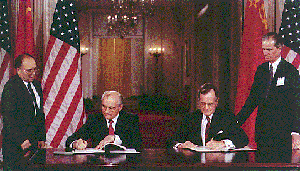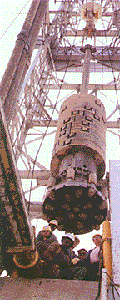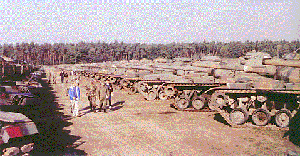
President Mikhail Gorbachev and President George Bush sign the Threshold Test Ban Treaty in the White House on June 1, 1990.
CHAPTER 9

President Mikhail Gorbachev and President George Bush sign
the Threshold Test Ban Treaty in the White House on June 1, 1990.
| On June 1,1990 at the Washington Summit President Bush and President Gorbachev signed the new Protocols to the Threshold Test Ban Treaty (TTBT) and the Peaceful Nuclear Explosions Treaty (PNET).1 These treaties, first signed in 1974 and 1976, limited the size of each signatory's underground nuclear explosions to 150 kilotons or less. The new Protocols authorized reciprocal verification rights, including monitoring nuclear tests through on-site inspections, seismic measurements, and under certain conditions, hydrodynamic measurements.2 |
| President Bush Directs OSIA Expansion | ||
 Drilling crew maneuvers large drilling bit into emplacement hole at the Nevada Test Site. |
These
treaties and their new protocols were the first of
several significant, new bilateral and multilateral arms
control agreements in 1990-1991. Recognizing that the
U.S. Government was entering into a new phase of
cooperative arms control agreements, President Bush
issued an executive directive just prior to the
Washington Summit. He expanded the On-Site Inspection
Agency's charter to include operational planning and
preparations for four arms control agreements under
negotiation: Conventional Armed Forces in Europe,
Chemical Weapons, Strategic Arms Reductions, and Nuclear
Testing.3 The
President cited three reasons: OSIA's extensive
experience in conducting on-site inspections under the
INF Treaty, the long lead times associated with
identifying, assigning, and training linguists, and the
pending series of new arms control treaties. With this
directive, President Bush changed the On-Site Inspection
Agency from a single- to a multi-treaty agency. Within the United States government, all treaties moved through a sequence of actions from treaty negotiation to implementation. The process began with diplomatic negotiations to develop the treaty text, protocols, and annexes. Presidential approval and formal signature, usually at a summit meeting, were followed by a presidential directive defining roles and missions for carrying out each aspect of the treaty. The Constitution required the President to submit the signed treaty to the U.S. Senate for its advice and consent. Following Senate hearings, debate, and ratification, the treaty was returned to the President for his signature and a formal exchange with the other signatories. Actual entry into force and implementation of the treaties began after the formal constitutional provisions had been met. For the two Nuclear Testing Treaties, TTBT and PNET, and their new protocols, the initial phases, diplomatic negotiations and presidential signature concluded with the Washington Summit of June 1, 1990. In defining which government departments and agencies would carry out the provisions of the treaties, the President's National Security Council staff surveyed existing laws, directives, and precedents. They incorporated President Bush's directive to expand the On-Site Inspection Agency with the laws and policies governing the Department of Energy's and the Department of Defense's conduct of underground nuclear tests. The result was President Bush's directive in mid-July l990. In defining the roles and missions for those departments and agencies responsible for the nuclear testing treaties. The Department of Energy would carry out all of its statutory obligations in planning, scheduling, and conducting the U.S. underground nuclear tests at the Nevada Test Site. The On-Site Inspection Agency would manage and support the on-site monitoring of the nuclear tests conducted under the Threshold Test Ban Treaty. Management included providing for team leadership, linguists, logisticians, and administrative support personnel. Support included responsibility for treaty training, funding, communications, logistics, and the construction of facilities including inspector housing and treaty-required seismic stations. Because of the technical nature of conducting controlled, underground nuclear tests and the complex rights and obligations under the new protocols to the treaty, the President stated that extensive coordination would be necessary between the Department of Energy, the On-Site Inspection Agency, and the other agencies of the Department of Defense involved in nuclear testing.4 |
| President
Bush submitted the treaties and new protocols to the U.S.
Senate in early July, 1990. From July to September, the
U.S. Senate Foreign Relations Committee held hearings on
the new protocols. Following hearings and debate, the
full Senate consented to ratification in late September
by a vote of 98-0. The Soviet Union's legislative body,
the Supreme Soviet, voted unanimously in early October to
ratify the two treaties and the new protocols. For the
next ten weeks, the treaties and accompanying documents
were readied for the formal exchange.5 While the Bush administration was working through these Nuclear Testing Treaties decisions and constitutional processes, negotiations on the Conventional Armed Forces in Europe (CFE) Treaty were moving toward a conclusion in the summer and fall of 1990. This was a complex, multinational treaty with multiple protocols for inspections, reductions, notifications, reclassificiation, and categorization. Personnel from OSIA, who had extensive experience in implementing the INF Treaty, advised American treaty negotiators working on the CFE Treaty. As the treaty negotiations grew progressively more detailed and intense, General Lajoie succeeded in placing some of the agency's most experienced INF team chiefs and inspectors as technical advisors on key backstopping committees and treaty working groups in Vienna, and Washington.6 When CFE Treaty negotiators in Vienna began focusing on inspection and reduction protocols, Lt. Colonel Paul Nelson, an experienced Army foreign area specialist and INF Treaty team leader, went to Austria and served as technical advisor to the U.S. delegation. After a month, Colonel John C. Reppert, US Army, a senior Soviet specialist and INF team leader, lent his expertise to the delegation. While these CFE negotiations were underway, General Lajoie dispatched Irene Nehonov, OSIA's Russian Language Coordinator, and Lt. Colonel Vitali Mostovoj, USAF, an OSIA team chief, on an extensive round-the-world trip to California, Hawaii, Japan, and Europe, to interview and evaluate hundreds of linguists for training and then assignment to the agency. More than one hundred and fifty linguists would be needed by 1992 to carry out the inspection and escort provisions of the new treaties. The first group of a continuing stream of these military linguists were entering formal training when the CFE Treaty was signed in Paris in mid-November 1990. President Bush went to Paris on November 19, 1990, where he joined the leaders of 21 nations in the formal signing ceremony for the CFE Treaty.7 Immediately thereafter, the President's National Security Council began the process of defining the roles and mission of those U.S. Government departments and agencies responsible for implementation. Since this was a treaty which focused exclusively on conventional arms--tanks, artillery, aircraft, and other military equipment--the U.S. Department of Defense was assigned principal responsibility. Within DOD, the U.S. European Command (EUCOM) and the On-Site Inspection Agency received specific missions in managing and carrying out the United States' treaty rights and obligations. At OSIA, General Lajoie acted quickly, instituting a major internal restructuring of the agency less than three weeks after the treaty was signed. |
 In their preparations for implementing the Conventional Armed Forces in Europe Treaty, OSIA inspectors and escorts participated in a series of site visits and trial inspections at U.S. Army sites in Europe. |
On December 1, 1990, OSIA's Field Office Europe was elevated to be the OSIA-Europe with responsibility for conducting all of the United States' CFE Treaty inspections.8 OSIA-Europe retained responsibility for serving as a gateway office, supporting both the INF Treaty and Threshold Test Ban Treaty missions. The CFE Treaty mission, however, meant a significant expansion. To carry out all aspects of the European operation, the command would be increased from 20 to 150 people. In Europe, three senior officers, Colonel Frederick E. Grosick, USAF, Colonel Lawrence G. Kelley, USMC, and Lt. Colonel Scott G. Lang, USA, directed the selection and recruitment of new team chiefs, deputies, linguists, inspectors, and support personnel. Training for these new inspectors required a rigorous regime because the CFE Treaty differed from other treaties in several important respects. There were five types of equipment--tanks, armed combat vehicles, artillery, aircraft, and helicopters--and approximately 188,000 treaty-limited equipment items. There were six official treaty languages: English, Russian, French, German, Spanish, and Italian. The number of treaty parties (22 in 1990), and the anticipated use of multinational inspection teams, also differed from the experience of the INF Treaty. At OSIA-Europe, Colonel Kelley and his staff concentrated their efforts on developing in each new inspection team a thorough knowledge of the treaty, skills to recognize the types and variations of treaty equipment, and a linguistic vocabulary for communicating and understanding treaty-specific information in multiple languages. At the same time, Colonel Grosick and Colonel Kelley worked with the U.S. European Command in devising and scheduling a series of CFE Treaty trial inspections. These trial inspections were conducted with the operational military forces and multinational inspection teams from the NATO alliance.9 |
Previous Chapter | Table of Contents | Next Section